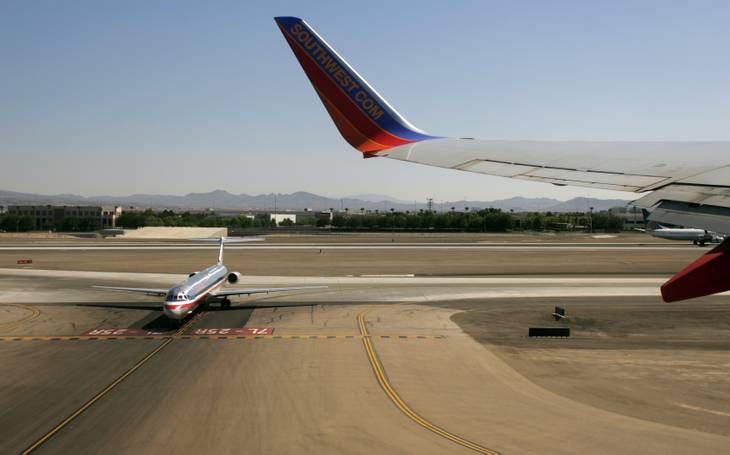Airline analysts are growing more confident that American Airlines and US Airways will merge — a move that probably wouldn’t have a big impact on Las Vegas’ flight schedules but could force ticket prices to go up.
US Airways fueled merger speculation last week when the suburban Phoenix-based airline announced that it had reached deals with three American Airlines unions on conditional labor agreements.
US Airways executives downplayed the significance of the deals, saying a merger, if viable, is still a long way off.
The Allied Pilots Association, the Transport Workers Union and the Association of Professional Flight Attendants reached agreements.
That’s good news for most of the 175 American employees in Las Vegas, who are among the 13,000 airline workers who could lose their jobs under parent company AMR Corp.’s restructuring plan filed in U.S. Bankruptcy Court in New York. A merger with US Airways could head off the AMR alternative.
Lawyers for AMR are in court this week and filed a motion seeking the elimination of $990 million in union contracts.
Analysts have said a merger could save many jobs because there’s little competitive crossover between American and US Airways. That’s particularly true in the Las Vegas market.
At McCarran, US Airways and American don’t compete on a single route.
US Airways has 21 daily flights from Las Vegas to Phoenix, Philadelphia, Charlotte, N.C., and Washington’s Ronald Reagan National Airport — all US Airways hubs. American has 25 daily flights to that airline’s hubs in Dallas-Fort Worth, Miami, New York’s John F. Kennedy International, Chicago’s O’Hare International and Los Angeles International.
Because of that lack of crossover, a new American Airlines would be less inclined to pare flights from the Las Vegas schedule, analysts say.
“Both American and US Airways are operating with at- or near-maximum load factors,” said Bob Herbst of AirlineFinancials.com. “As such, it is unlikely their merger would cause reductions in labor forces, with the exception of some mid- to upper-level management positions.”
Consumer advocates have a different worry — that the price of the average ticket will climb, because less competition usually translates to higher prices.
Las Vegas is particularly vulnerable to price fluctuations because it’s one of the lowest-yielding markets in the country. The majority of its customers are leisure travelers and not higher-spending business customers.
Las Vegas is somewhat insulated from price spikes, however, because Southwest is the dominant player in the market and some other significant low-fare airlines — JetBlue, Virgin America and Frontier, for example — have a presence here.
“In 2005, the Big Three networks of American, Delta and United — along with Southwest — controlled roughly half of domestic capacity,” said analyst Jamie Baker of J.P. Morgan in a report. “If US Airways and American successfully merge, close to 90 percent will be concentrated in the hands of just four airlines. Sure, two airlines controlling 100 percent market share might sound better (for investors), but let’s be realistic. Four airlines with 90 percent market share represent the optimal industry structure and should allow for consistent return generation going forward, in our view.”
US Airways’ management has had no qualms about cutting less profitable routes in the past four years, modifying the company’s business model to focus on higher yields and hub flying instead of leisure market routes that were popular when the airline operated as America West Airlines.
The end result was that America West, once the dominant air carrier at McCarran, shrank in its merger with US Airways and became a second-tier player in Las Vegas under its new philosophy.
US Airways CEO Doug Parker has been an advocate for industry consolidation and mergers and would be the presumed head of the new Fort Worth, Texas-based American.
“The easiest way to fight volatile fuel prices is not with market-share battles and double-digit growth in hypercompetitive markets during a recession, but with less capacity,” Daniel McKenzie, an analyst with Rodman & Renshaw, said in a report to investors.
Analysts say American’s survival may depend on a merger and, by process of elimination, US Airways is the likeliest partner.
Some have identified JetBlue as a prospective merger partner with American, but most analysts think Parker’s drive would push US Airways to be the lead prospect. They say Delta and United wouldn’t be in the running because the Justice Department would not allow either of those carriers to become the dominant market player.
If American were to merge with US Airways, the blended airline would become the largest ahead of United and Delta.
“In every potential transaction, there is a consequence to doing it and there is a consequence to not do it,” Herbst said. “The merger of US Airways and American has far more positive benefits than negative ones and their merger would play a major role in making the U.S. airline industry better.”
“We think AMR’s stand-alone ambitions could be materially detrimental to industry prosperity,” Baker added. “To be fair, we certainly understand why AMR came up with its plan, but we just view it as a step backward for the industry. We believe a significant component of the value created by a US Airways-American merger is measured in the avoidance of value destruction that could occur absent a merger.”
